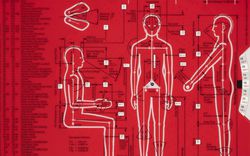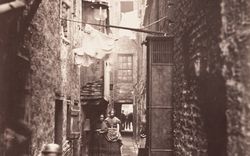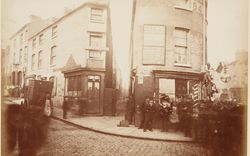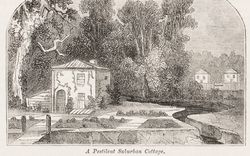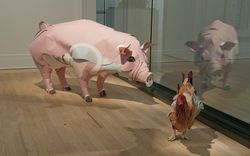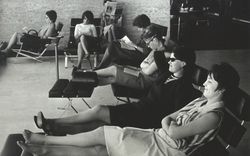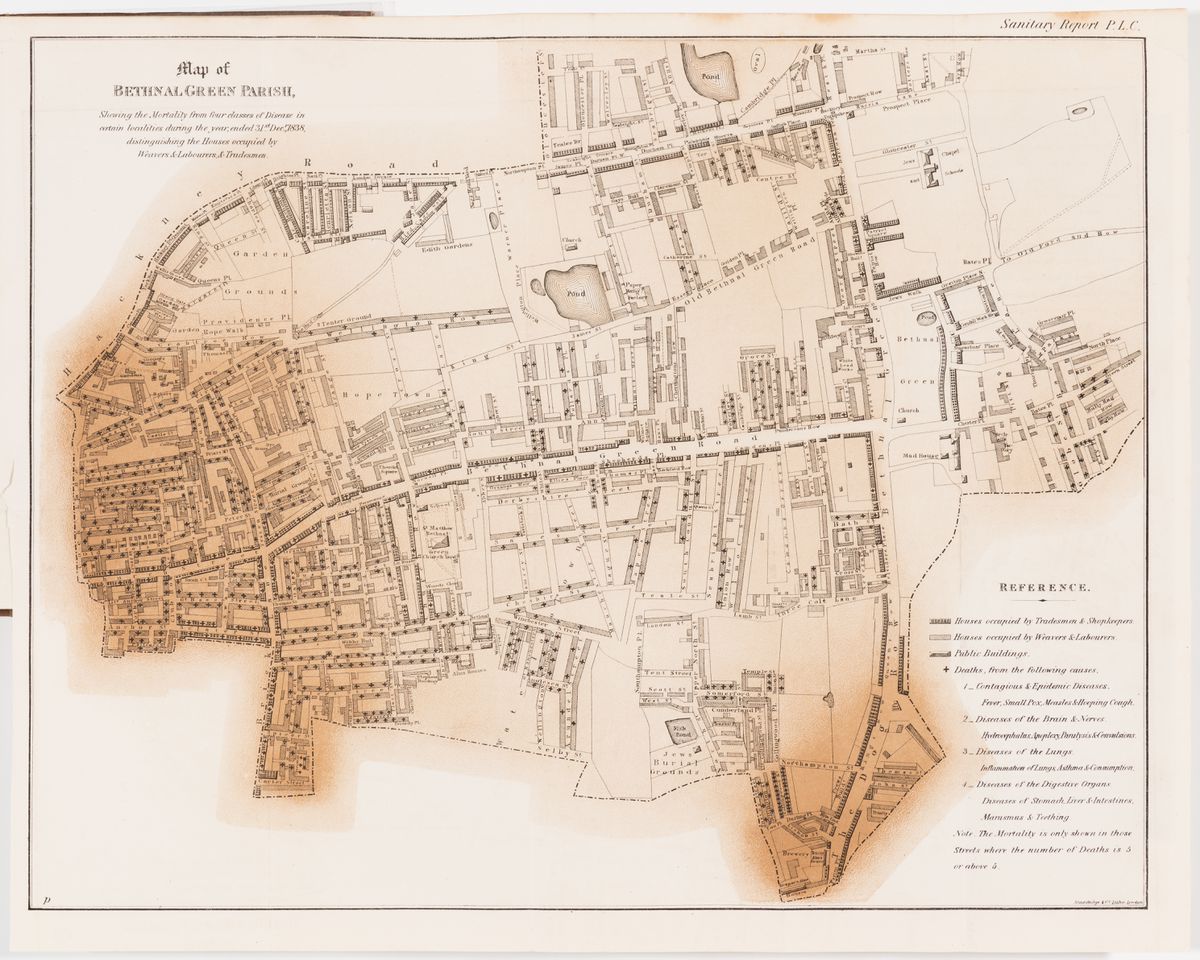Corpus sanum in domo sano
Text by Annmarie Adams
The idea of Corpus sanum in domo sano—a healthy body in a healthy house—was at the heart of the late-nineteenth century Domestic Sanitation Movement in England. Even a cursory glance at popular magazines, advice books for women, medical texts, plumbing manuals, and trade catalogues of the period reveals the enormous power vested in “healthy” domestic architecture by the middle class between 1870 and 1914.
The Domestic Sanitation Movement was a relatively late development in the Victorian health movement.1 At midcentury, British sanitarians had concentrated their reform efforts on working-class housing and on large-scale municipal improvements.2 Appalled by the overcrowded slums, open gutters of raw sewage, and inadequate water supply of many industrialized cities, health reformers and social critics—among them Edwin Chadwick, Henry Mayhew, and Friedrich Engels—conducted exhaustive surveys of sanitary conditions in the working-class districts of urban centres. Their persuasive analyses, coupled with the impetus for improvement generated by London’s cholera epidemics of 1832 and 1848, resulted in the massive public-works projects of the 1850s and 1860s. Joseph Bazalgette’s ingenious sewer system for London, the Embankment of the Thames River, and widespread slum clearance in British cities became extremely important models for public-health reform around the world. Indeed, urban reform in both Canada and the United States followed this two-part British model: urban investigation followed by state-sponsored change.3
Read more
-
Nancy Tomes has noted this sequence in her fine analysis of the American Domestic Sanitation Movement from the perspective of medical history. See Nancy Tomes, “The Private Side of Public Health: Sanitary Science, Domestic Hygiene, and the Germ Theory, 1870–1900,” Bulletin of the History of Medicine 64, no. 4 (winter 1990): 510. ↩
-
The sanitary reform of working-class housing in nineteenth-century England has been the subject of many studies. See Asa Briggs, Victorian Cities (Harmondsworth: Penguin Books, 1985); John Burnett, A Social History of Housing: 1815–1970 (Newton Abbott: David and Charles, 1978); M. J. Daunton, House and Home in the Victorian City: Working Class Housing, 1850–1914 (London: Edward Arnold, 1983); H.J. Dyos and Michael Wolff, eds., The Victorian City: Images and Realities, 2 vols. (London: Routledge & Kegan Paul, 1973); S. Martin Gaskell, Model Housing: From the Great Exhibition to the Festival of Britain (London: Mansell, 1987); Enid Gauldie, Cruel Habitations: A History of Working-Class Housing, 1780–1918 (London: Allen and Unwin, 1974); Francis Sheppard, London 1808–1970: The Infernal Wen (Berkeley: University of California Press, 1971). On the impact of photography on urban reform, see Eve Blau, “Patterns of Fact: Photography and the Transformation of the Early Industrial City,” in Architecture and Its Image, eds. Eve Blau and Edward Kaufman (Montreal: Canadian Centre for Architecture, 1989), 36–57. ↩
-
On urban reform in Canada, see Paul Rutherford, “Tomorrow’s Metropolis: The Urban Reform Movement in Canada: 1880–1920,” in The Canadian City: Essays in Urban and Social History, eds. Gilbert A. Stelter and Alan F. J. Artibise (Ottawa: Carleton University Press, 1984), 435–455. On American sanitary reform, see John Duffy, The Sanitarians: A History of American Public Health (Urbana: University of Illinois Press, 1990) and Barbara G. Rosenkrantz, Public Health and the State: Changing Views in Massachusetts, 1842–1936 (Cambridge, MA: Harvard University Press, 1972). ↩
Around 1870, British Sanitarians turned their attention to the health of the urban middle class. At the same time, they altered their approach to health reform. Instead of imposing urban improvements on householders from above, through municipal controls, the sanitarians attempted to convince educated, middle-class householders to regulate their own physical health through the sanitary regulation of their houses. This program of enlightened self-improvement constituted a basic tenet of the new field of “sanitary science.”1
It also reflected, as many social and medical historians have noted, fundamental changes in the ways people thought about disease. Prior to the Victorian period, disease and death had typically been associated with unseemly or inappropriate behaviour; Victorian medical experts, however, pointed to environmental rather than moral causes for the spread of disease. The pivotal effect of this new attitude has been noted by historian James Walvin, who pointed out that “to believe that poverty and disease were functions of personal failings was to argue that little could be done about them. To locate their causes (largely if not completely) in the environment was to claim that they could be improved by changing that environment.”2
In an effort to instruct householders in the improvement of their own domestic environments, courses in sanitation were taught in most English schools; by 1870, hygiene was the subject of royal commissions and government boards, and Sanitary Institutes were common in many English cities. It was through the architecture of their own houses—sanitary inspection, rearrangement, and even redecoration—that the middle class expressed their mastery of sanitary science and, by extension, control of their own bodies.
The medical profession shaped the perspective of the movement from the beginning. Edmund Alexander Parkes is often considered the founder of the “science of modern hygiene.”3 The Parkes Museum of Hygiene in London, dedicated to continuing his pioneering work, was established in his memory in 1877. Another influential British physician, Benjamin Ward Richardson, lectured extensively on domestic sanitation. While architects, engineers, plumbers, city officials, social scientists, writers, and lay people also contributed to the movement, the Domestic Sanitarians were by the 1870s a coherent and highly visible group whose common goals were defined in terms of a primarily medical discourse.
While the medical profession shaped the sanitary movement, health reform also affected the practice of medicine and its relationship to urban space. Since the new field of sanitation was based on the notion of health as a public concern, the impetus for improvement demanded the expansion of the conception of disease from the scale of the individual to that of the community. As sanitarians, physicians were no longer concerned simply with how the body acted as a setting for disease but rather with how the spaces between bodies accommodated illness.4 They extended the scope of their investigation from the body to the room, the house, the street, and the city—visible and observable spaces from which they could document and attempt to control the seemingly invisible movement of disease through air, water, walls, streets, people, and things.
In applying their command of physiology to urban spaces, physicians defined a new form of expertise in architecture. Many of the doctors in the Domestic Sanitation Movement became, in a sense, “building doctors,” called upon to diagnose, treat, and heal buildings, as a physician would traditionally have dealt with an individual patient. Many doctors even designed buildings. Physician John Drysdale designed a suburban house in Liverpool in 1861; his medical colleague John Williams Hayward adapted Drysdale’s unique system of ventilation to an urban site in 1867.5 Benjamin Ward Richardson designed “Hygeia,” an entire city of health, in 1876.6 Physicians George Vivian Poore in England and “Dr. Frank” in the United States were active architectural consultants, prescribing the use of building materials and the proper orientation for architecture. Their apparent expertise in assessing the delicate relationship of health to the environment, in the guise of a more “scientific” approach to architecture, appealed to a middle-class population desperate for new solutions to seemingly insoluble health problems.
-
Many historians have identified the urge for self-improvement or self-help as a major force in nineteenth-century middle-class society. See Asa Briggs, “Samuel Smiles and the Gospel of Work,” in Victorian People: A Reassessment of Persons and Themes 1851–67 (Chicago: University of Chicago Press, 1972), 116–139, and Walter E. Houghton, The Victorian Frame of Mind 1830–1870 (New Haven: Yale University Press, 1974), 237–239. On the idea of self-help in health reform, see Regina Markell Morantz, “Nineteenth Century Health Reform and Women: A Program of Self-Help,” in Medicine Without Doctors: Home Health Care in American History, eds. Guenter B. Risse, Ronald L. Numbers, and Judith Walzer Leavitt (New York: Science History Publications, 1977), 73–93. ↩
-
James Walvin, Victorian Values (London: Cardinal, 1987), 34. ↩
-
“Parkes, Edmund Alexander,” The Dictionary of National Biography (1964). ↩
-
The environmental aspect of Victorian medicine is evident in the increased use of maps in public-health reports. See James Elliot, “Medical and Social Mapping,” in The City in Maps: Urban Mapping to 1900 (London: British Library, 1987), 78–81, and S. Jarcho, “Yellow Fever, Cholera, and the Beginning of Medical Cartography,” Journal of the History of Medicine and Allied Sciences 25 (1970): 131–142. ↩
-
The plans, sections, and descriptions of these houses were published in J. Drysdale and J. W. Hayward, Health and Comfort in House Building (London: Spon, 1876). ↩
-
Benjamin Ward Richardson, Hygeia, a City of Health (London: Macmillan, 1876). See James H. Cassedy, “Hygeia: A Mid-Victorian Dream of a City of Health,” Journal of the History of Medicine and Allied Sciences 17 (1962): 217–228. ↩
Thomas Pridgin Teale, a Leeds surgeon, was typical of the “building doctors” of the Domestic Sanitation Movement. He expanded his medical practice to the assessment of his patients’ houses after checking the health of his own house. “Many of the medical men of this town,” he wrote in the introduction to his classic book of 1878, Dangers to Health, “have recently gone into the question of the sanitation of their own houses …[becoming] more keenly alive to possible sources of illness among their patients.”1 Teale’s conviction that more than a third of all diseases could be traced to defective house drainage convinced him of the merits of publishing a book “on a subject which at first sight may appear to be outside the lines of my strictly professional work.”2 As doctors crossed the “lines” of long-established professional territories and extended their sphere of expertise to architecture, they had a profound effect on the way people understood architecture.
Physicians sought to establish their own authority in architectural matters by discrediting those traditionally responsible for building construction: architects, engineers, contractors, and plumbers. They claimed the practice of architecture—supposedly unlike their own profession of medicine—lacked “scientific” principles; and they attempted to “systematize” the house as modern medicine had systematized the body.3 Indeed, Benjamin Ward Richardson claimed the “scientific” view of the house was the major objective of the Domestic Sanitarians.4
The exposure of substandard work by architects formed the doctors’ major agenda. “When we have discovered what is wrong,” said Teale, “we are more than half way to what is right.”5 Teale’s book was intended to instruct ordinary householders in the detection of the poor workmanship of building professionals. Most of the defects concerned drainage, although he also pointed out ways to check inadequate ventilation and poor lighting. Teale’s main contention was concerned with construction: “Probably no work done throughout the kingdom is so badly done as work in houses, drains, and pipes, which is out of sight. Probably no work is better done in the kingdom than the locomotives turned out for our railways, or the machinery which we send to all parts of the world.... The difference is this: Necessity in the one case compels good work: indifference and ignorance in the other case allow bad work to pass unchallenged.”6
This exposure by the sanitarians of unhealthy construction techniques set in motion a distinctive tone of alarm among middle-class householders. Why hire builders, plumbers, or architects, when their seemingly specialized knowledge of construction served to deceive unwary clients? Also, if architecture could be distilled to basic principles and expressed in relatively simple terms, why not do it yourself?
The architects defended their own professional territory by insisting that too much “scientific” knowledge was harmful to the practice of architecture. A journalist explained: “It is very much to be suspected, when we ask the apparently simple question – what a London house is – that some of those eminent scientists who are now so devoted to the study of its organisation may be fast approaching a condition of mind which must cause them before long to abjure the shelter of a roof altogether for fear of being poisoned underneath.”7
Architects were also quick to point out the limits of medical authority in building construction: “In arrogating to themselves any exclusive capacity to remedy the faults in dwellings, the medical officers of health are unwise, and the most strenuous opposition would come from some of their own body. If an engineer were to profess to treat disease, the absurdity would at once be seen, but it appears to be overlooked when a medical officer of health professes to deal with engineering and construction.”8
The overall impact of the Domestic Sanitation Movement on the prestige of the architectural profession in England was devastating. Although architects appeared to play a relatively important role in the reform of the middle-class house, they were reduced by the doctors to mere consultants, building “technicians” who would serve only to realize the principles established by the medical profession. “It is the principle only which I wish to illustrate,” said physician George Vivian Poore of a house he designed, “the method of carrying it out will certainly be improved by the experience and cunning of the trained architect.”9
The physicians’ attempt to monopolize domestic sanitation by convincing the public of their own exclusive ability to check sanitary architecture was strengthened by their suggestion that the diagnosis of houses was precisely the same enterprise for which their authority was already well established; houses, they implied, were like bodies.10 They strengthened their case by explaining domestic architecture using the language and the illustrative techniques of contemporary physiology. Both houses and bodies were represented in the Victorian popular press in cross-section, to show the complex networks of overlapping systems. This type of drawing emphasized the flow and interplay of air, water, waste, and other substances, through the structure. As the physiological systems of respiration, circulation, and digestion are linked inextricably in the human body, so too, implied the doctors, ventilation, drainage, and the supply of fresh water work together in the house. Illustrations of buildings based on this physiological model appeared to a lay audience as much more scientific than traditional architectural drawings, revealing the disease-ridden drains and pipes that, as Teale pointed out, often passed unnoticed in the real world because they were out of sight.
-
T. Pridgin Teale, Dangers to Health: A Pictorial Guide to Domestic Sanitary Defects (London: Churchill, 1878), 6. ↩
-
Ibid., 5. ↩
-
Historian Burton Bledstein has identified the establishment of distinct principles as a significant aspect of Victorian professionalism. See Burton J. Bledstein, The Culture of Professionalism: The Middle Class and the Development of Higher Education in America (New York: Norton, 1976), 88. ↩
-
Benjamin Ward Richardson, “Our Homes, and How to Make Them Healthy,” in Our Homes, and How to Make Them Healthy, ed. Shirley Forster Murphy (London: Cassell, 1883), l. ↩
-
Teale, 8. ↩
-
Ibid., 6–7. ↩
-
“What is a London House?,” The Architect, 4 December 1880, 347. ↩
-
“Medical Officers of Health v. Sanitary Engineers and Architects,” The Sanitary Record, 16 July 1888, 11. ↩
-
George Vivian Poore, The Dwelling House (London: Longmans, Green, and Co., 1898), 11. ↩
-
Magali Sarfatti Larson has identified the “negotiation of cognitive exclusiveness” as a distinctive characteristic of nineteenth-century professionalism. See Magali Sarfatti Larson, The Rise of Professionalism: A Sociological Analysis (Berkeley: University of California Press, 1977), 15–18, 30–31; for a discussion of how nineteenth-century American architects fitted Larson’s model of professionalism, see Dell Upton, “Pattern Books and Professionalism: Aspects of the Transformation of Domestic Architecture in America, 1800–1860,” Winterthur Portfolio 19, nos. 2–3 (summer/autumn 1984): 112–114. ↩
The distinctions between house and body became blurred in the 1870s and 1880s by doctors who also employed the reverse metaphor, explaining the body in terms of the house. In the popular physiology textbook The Marvels of Our Bodily Dwelling (1899), physician Mary Wood-Allen began, “Let us study the body as a house in which we dwell here on earth, a house created by a divine Architect, fitted up with every comfort, divided into many rooms, each with its own appropriate furniture and adapted to its own especial use. It is a beautiful building, more exquisitely adorned than any structure of man’s creation.”1 Wood-Allen pushed the house-body metaphor to an extreme, stating that the idea was not original, but “as old as literature.” Her personal contribution, she maintained, was that she had “united metaphor with scientific facts.”2
This merging of the body and house by physicians active in the Domestic Sanitation Movement depended on faith in the visible relationship of the environment to health.
There was still, at the time of the Domestic Sanitation Movement, widespread disagreement over the exact nature of disease transmission.3 The miasma theory held that infection was generated spontaneously in sewage or filth and was then transported by foul air. Followers of this popular theory believed houses could absorb these miasmas and then release them, poisoning the occupants. The miasmatists’ concern for ventilation is reflected in period images of the sick, particularly tuberculosis patients, who were nearly always shown in close proximity to an open window. Contagionists, on the other hand, insisted disease was accommodated in organisms and passed by direct contact. Not surprisingly, the contagionists concentrated their reform efforts on problems associated with overcrowding.4 Both theories inspired a near-obsession with drainage, and exponents of each saw an improved domestic environment as a form of preventive medicine.
Both the “diagnosis” and “regulation” of domestic architecture fell to middle-class women.5 They were the doctors’ most trusted all ies in the Domestic Sanitation Movement because of a supposed familiarity with the architecture of home. “The men of the house come and go; know little of the ins and outs of anything domestic; are guided by what they are told, and are practically of no assistance whatever,” claimed Richardson. “The women are conversant with every nook of the dwelling, from the basement to roof, and on their knowledge, wisdom, and skill the physician rests his hopes.”6 Mrs. Harriette Plunkett, one of the few women to write about sanitation, claimed that if women and plumbers did their whole duties, there would be no need for doctors. “Her sphere,” she claimed of the homemaker, “begins where the service-pipe for water and the house-drain enter the street-mains, and, as far as sanitary plumbing goes, it ends at the top of the highest ventilating-pipe above the roof.”7 Mrs. Plunkett pleaded with women to break out of old-fashioned roles that assumed they could not understand “complicated piping.” “There is nothing in hygiene,” Mrs. Plunkett claimed, “that she can not comprehend.”8
-
Mary Wood-Allen, The Marvels of Our Bodily Dwelling (Ann Arbor: Wood-Allen Publishing, 1899), 15. ↩
-
Ibid., 4. ↩
-
A review of Victorian theories of infection is offered in Ervin Ackerknecht, “Contagionism and Anticontagionism between 1821 and 1867,” Bulletin of the History of Medicine 22 (September/October 1948): 562–593. Earlier theories are explained in Oswei Temkin, “An Historical Analysis of the Concept of Infection,” in The Double Face of Janus and Other Essays in the History of Medicine (Baltimore: Johns Hopkins University Press, 1977), 456–471. ↩
-
Medical historian George Rosen has identified a third theory, “limited contagion,” that held that organisms relied on particular atmospheric conditions for transmission, combining the contagionist and non-contagionist positions. See George Rosen, “Disease, Debility, and Death,” in The Victorian City: Images and Realities, vol. 2, eds. H.J. Dyos and Michael Wolff (London: Routledge & Kegan Paul, 1973), 635. ↩
-
A closer analysis of these gender implications is offered in my “Architecture in the Family Way: Health Reform, Feminism, and the Middle-Class House in England, 1870–1900” (PhD dissertation, University of California at Berkeley, 1992). On women in urban sanitary reform, see Suellen M. Hoy, “‘Municipal Housekeeping’: The Role of Women in Improving Urban Sanitation Practices, 1880–1917,” in Pollution and Reform in American Cities, 1870–1930, ed. Martin V. Melosi (Austin: University of Texas Press, 1980), 173–198; Regina Markell Morantz, “Making Women Modern: Middle Class Women and Health Reform in 19th Century America,” Journal of Social History 10 (1977): 490–507. ↩
-
“Domestic Economy,” Englishwoman’s Review 8 (15 August 1877): 350. ↩
-
Harriette M. Plunkett, Women, Plumbers, and Doctors or, Household Sanitation (New York: Appleton, 1885), 94. ↩
-
Ibid., 10. ↩
A proliferation of books and articles written by the Domestic Sanitarians appeared in the 1880s and 1890s in both England and the United States in this effort to explain sanitation to women.1 Experts typically recommended a series of simple tests for the maintenance of a healthy house. Drainage could be checked, for example, by running peppermint oil into the main drain from outside a building. If a minty smell were detected inside, the house was unsanitary. Ventilation, air temperature, humidity, and water purification were also to be regulated by women.2 One test for air quality was to hold a candle at the keyhole of an interior door. A flickering flame indicated “drain-derived” air, believed by some physicians to cause diptheria, typhoid, as well as the mysterious “sewer-air fever.”3
Interest in domestic sanitation reached its apex at the International Health Exhibition, held in London in 1884. “The Healtheries,” as the fair was called at the time, was intended by its promoters to celebrate international progress in the scientific study of health. Attracting an astonishing crowd of more than four million visitors, the fair was a testament to the public’s fascination with the new field of “sanitary science,” as well as a testament to Victorian faith in the power of spaces and objects to improve public health.
Not surprisingly, domestic architecture was the subject of a major display at the fair: Sanitary and Insanitary Dwellings. Two models shown in section represented an improved and an ordinary house, and their relationship to health. The models were sufficiently large to allow visitors to move through them, intended to incite fear by their resemblance to the fairgoer’s own house.4 “How can that be unhealthy?” remarked a visitor. “We have exactly the same kind of thing in our house, and that is not unhealthy!”5 The architect or plumber, the exhibit warned by implication, may have hidden such insanitary details in the walls, knowingly poisoning the inhabitants.
-
Major texts written explicitly for women included Mrs. Plunkett and Helen Dodd, The Healthful Farmhouse By a Farmer’s Wife (Boston: Whitcomb & Barrows, 1906); many women’s magazines and decorating advice manuals also included information on sanitation. ↩
-
Richardson listed what he believed to be the sanitary responsibilities of women in Benjamin Ward Richardson, “Woman as a Sanitary Reformer,” in Report on the Fourth Congress of the Sanitary Institute of Great Britain 2 (London: Office of the Institute, 1880), 196. Middle-class women were also active as lecturers and advisers in sanitary matters to working-class women, in England through the Ladies’ Sanitary Association. See SRP, Remarks on Woman’s Work in Sanitary Reform (London: Jarrold, n.d.), and BRP, “The Ladies’ Sanitary Association,” The English Woman’s Journal 3, no. 14 (April 1859): 73–85. ↩
-
On the dangers associated with “sewer gas,” see Richardson, “Our Homes,” 9–10; “Sewer Gas: Controversies Concerning It and New Means of Disposing of It,” The Sanitary Record, 2 July 1894, 761–762; “Sewer Air,” The Sanitary Record, 22 December 1894, 1266. ↩
-
No images of the models have survived; descriptions appeared in “Sanitary and Insanitary Dwellings,” The Architect, 23 August 1884, 116–117; “The Sanitary and Insanitary Houses at the Health Exhibition,” The Builder, 16 August 1884, 221–222; and The International Health Exhibition Official Guide (London: Clowes, 1884), 53. A detailed description appeared in the Guide to the Sanitary and Insanitary Houses (London: International Health Exhibition, 1884). This guide was destroyed in the bombing of London in World War II, but was microfilmed by the British library previously. See 8L-MIC A 8036 (8). On other buildings at the International Health Exhibition, see “The International Health Exhibition,” The Builder, 3 May 1884, 601–602 and “The Health Exhibition,” The Builder, 17 May 1884, 687–688; Douglas Galton, “The International Health Exhibition,” The Art Journal New Series 4 (1884): 153–156, 161–164, 293–296; Ernest Hart, “The International Health Exhibition: Its Influence and Possible Sequels,” Journal of the Society of Arts (28 November 1884): 35–58; George Augustus Sola, “The Health Exhibition: A Look Around,” The Illustrated London News, 2 August 1884, 90–95; and The International Health Exhibition Official Guide. ↩
-
“The Sanitary and Insanitary Houses at the Health Exhibition,” The Builder, 16 August 1884, 222. ↩
Many of today’s health concerns echo the assumptions made by the Domestic Sanitarians. Our current debate over “sick-building syndrome”—modern buildings that unintentionally generate illnesses—recalls in many ways the destructive powers attributed by Victorians to houses and cities.1 Even the medical symptoms arising from the use of modern building materials like formaldehyde resemble the health problems associated with the arsenical wallpapers, untrapped drains, and poor ventilation of houses built a century ago. An “environmental” approach to health thus predates modern architecture by several decades, rather than emerging, as is often implied, from the energy crisis of the 1970s.
In Victorian times, as well as today, perceptions of the body illuminate significant notions about architecture. It is only by reconstructing the shifting boundaries between the body, the room, the house, and the city that we can begin to understand the complexities of urban life.
-
For a review of the debate, see Madeline Drexler, “Sickbuilding Syndrome,” Boston Globe Magazine, 4 December 1988, 78; Hal Levin and Kevin Teichman, “Technics Indoor Air Quality - For Architects,” Progressive Architecture 72, no. 3 (March 1991): 52–57. ↩
This text originally appeared in a book accompanying our 1991 exhibition Corpus sanum in domo sano: The Architecture of the Domestic Sanitation Movement, 1870–1914.
